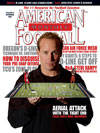AMERICAN FOOTBALL MONTHLY THE #1 RESOURCE FOR FOOTBALL COACHES
Article CategoriesAFM Magazine
|
Disguising Your Pre-Snap Defenseby: David Purdum© More from this issue Sometimes the best way to disguise a defense is with no disguise at all. Miami (OH) defensive backs coach Tim Cooper relies on that type of deception to confuse offenses. Instead of throwing multiple looks at offenses, Cooper often prefers that the Redhawks defense looks identical to the way it did on the previous play. That doesnt mean Miami will never use pre-snap movement. Stemming the line, bluffing pressure with creeping linebackers and showing multiple-safety looks are all ingredients used to create the Redhawks defensive disguise. Building the Disguise The Redhawks base defense seems simple enough: a 4-3, Cover-2. The safeties are ten yards off the ball on the hash marks and the corners are in press coverage. Its a look offenses become very familiar with throughout a game; it is one that h....The full article can only be seen by subscribers. Subscribe today!
|
|
|||||||
| HOME |
MAGAZINE |
SUBSCRIBE | ONLINE COLUMNISTS | COACHING VIDEOS |
Copyright 2025, AmericanFootballMonthly.com
All Rights Reserved





